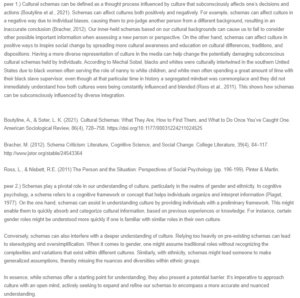Response – How Schemas Assist and Interfere with Understanding Culture
Responding To Peer 1
Hello,
Thank you for your informative post on how schemas may both help and hinder cultural understanding, with a focus on gender and race. You’ve brought up the dual nature of cultural schemas, which can positively and negatively affect our perceptions and relationships with people from other cultures. Cultural schemas, as you indicated, can lead to prejudices and pre-judgments, allowing people to draw incorrect assumptions about others based on their cultural backgrounds. This impediment to understanding culture has the potential to perpetuate stereotypes and reinforce existing biases, which is harmful to encouraging tolerance and diversity. Cultural schemas can help people comprehend culture by boosting awareness and promoting education about cultural differences, traditions, and perspectives (Jehan et al., 2023). Finally, your piece demonstrates how cultural schemas may hinder and help our understanding of culture, especially in the context of gender and race. We should strive for a more inclusive and culturally sensitive society by understanding the inherent hazards of schemas and actively attempting to extend our perspectives through exposure and education.
References
Jehan, S., Khan, F. U., & Wahab, A. (2023). Unlocking the Power of Schema Theory based Pre-Reading Activities: Enhancing Reading Comprehension at the Intermediate Level. Global Social Sciences Review, VIII(II), 274–283. https://doi.org/10.31703/gssr.2023(viii-ii).25
Responding To Peer 2
Hello,
Thank you for carefully examining how schemas influence our knowledge of culture, particularly in the contexts of gender and ethnicity. Your definition of schemas as cognitive frames is correct, and it provides a robust platform for exploring their impact on our understanding of culture. Your identification of schemas as aiding and impeding our comprehension of culture is perceptive. Schemas, without a doubt, function as mental shortcuts that help in effectively processing and categorizing information (Landström et al., 2022). This can be useful when confronted with new cultural circumstances. On the other hand, your caution about the propensity for schemas to lead to oversimplification and stereotyping is critical. Your emphasis on approaching culture with an open mind and actively seeking to expand and enhance our schemas is consistent with promoting cultural sensitivity and inclusivity. Indeed, understanding culture necessitates ongoing learning and a willingness to question our preconceived notions and assumptions. Doing so allows us to go beyond surface-level comprehension and embrace a more genuine and nuanced view of gender, ethnicity, and culture.
References
Landström, S., Granhag, P. A., & Koppen, P. J. van. (2022). The Future of Forensic Psychology: Core Topics and Emerging Trends. Taylor & Francis.
ORDER A PLAGIARISM-FREE PAPER HERE
We’ll write everything from scratch
Question

How Schemas Assist and Interfere with Understanding Culture
peer 1.) Cultural schemas can be defined as a thought process influenced by culture that subconsciously affects one’s decisions and actions (Boutyline et al., 2021). Schemas can affect cultures both positively and negatively. For example, schemas can affect culture in a negative way due to individual biases, causing them to pre-judge another person from a different background, resulting in an inaccurate conclusion (Bracher, 2012). Our inner-held schemas based on our cultural backgrounds can cause us to fail to consider other possible important information when assessing a new person or perspective. On the other hand, schemas can affect culture in positive ways to inspire social change by spreading more cultural awareness and education on cultural differences, traditions, and dispositions. Having a more diverse representation of culture in the media can help change the potentially damaging subconscious cultural schemas held by individuals. According to Mechal Sobel, blacks and whites were culturally intertwined in the southern United States due to black women often serving the role of nanny to white children, and white men often spending a great amount of time with their black slave supervisor, even though at that particular time in history a segregated mindset was commonplace and they did not immediately understand how both cultures were being constantly influenced and blended (Ross et al., 2011). This shows how schemas can be subconsciously influenced by diverse integration.
Boutyline, A., & Soter, L. K. (2021). Cultural Schemas: What They Are, How to Find Them, and What to Do Once You’ve Caught One. American Sociological Review, 86(4), 728–758. https://doi.org/10.1177/00031224211024525
Bracher, M. (2012). Schema Criticism: Literature, Cognitive Science, and Social Change. College Literature, 39(4), 84–117. http://www.jstor.org/stable/24543364
Ross, L., & Nisbett, R.E. (2011) The Person and the Situation: Perspectives of Social Psychology (pp. 196-199). Pinter & Martin.
peer 2.) Schemas play a pivotal role in our understanding of culture, particularly in the realms of gender and ethnicity. In cognitive psychology, a schema refers to a cognitive framework or concept that helps individuals organize and interpret information (Piaget, 1977). On the one hand, schemas can assist in understanding culture by providing individuals with a preliminary framework. This might enable them to quickly absorb and categorize cultural information, based on previous experiences or knowledge. For instance, certain gender roles might be understood more quickly if one is familiar with similar roles in their own culture.
Conversely, schemas can also interfere with a deeper understanding of culture. Relying too heavily on pre-existing schemas can lead to stereotyping and oversimplification. When it comes to gender, one might assume traditional roles without recognizing the complexities and variations that exist within different cultures. Similarly, with ethnicity, schemas might lead someone to make generalized assumptions, thereby missing the nuances and diversities within ethnic groups.
In essence, while schemas offer a starting point for understanding, they also present a potential barrier. It’s imperative to approach culture with an open mind, actively seeking to expand and refine our schemas to encompass a more accurate and nuanced understanding.
References:
Piaget, J. (1977). The development of thought: Equilibration of cognitive structures. Viking.
Lee Ross, R. E. (2011). The Person and The Situation Perspectives of Social Psychology. London: Pinter and Martin Ltd.

